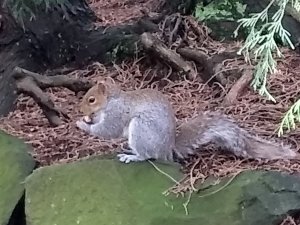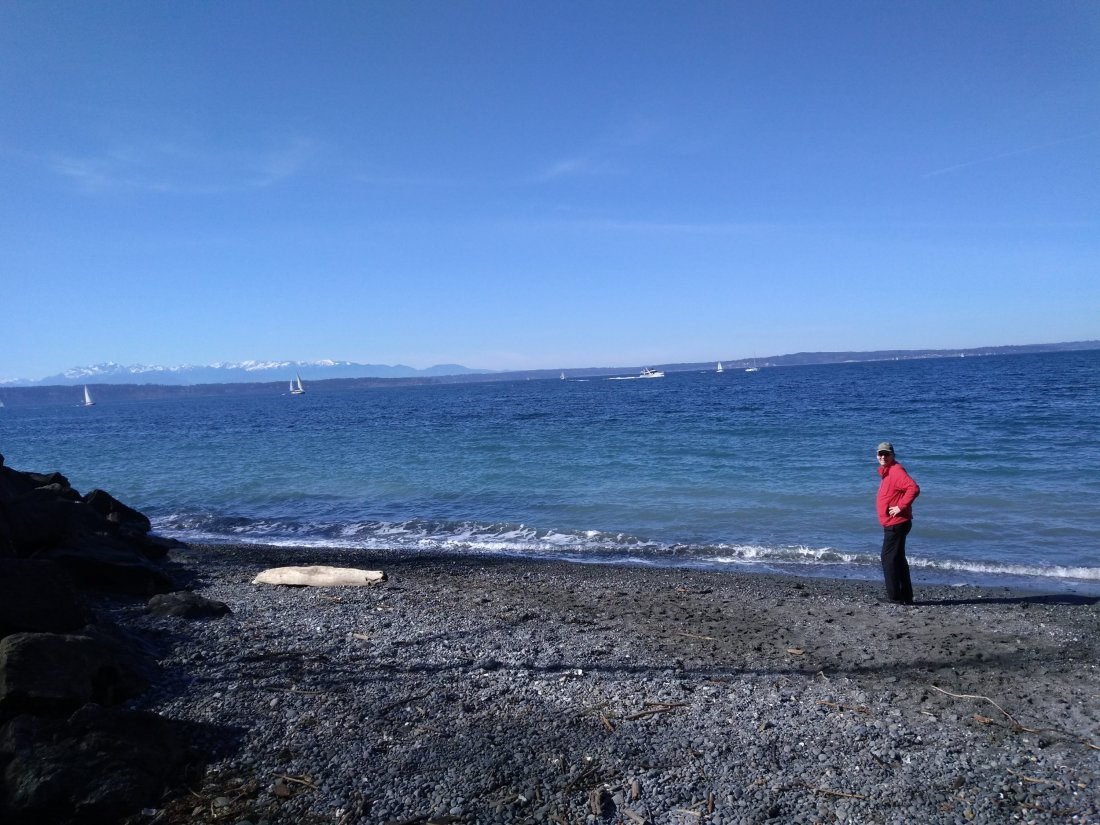April 18, 2019
Winter and early spring have flown by as we explored Seattle. Opportunities to observe wildlife were surprisingly abundant in the midst of this fascinating “big city”.
One day we hiked around Green Lake which boasts a wide flat asphalt and gravel path, quite popular with groups of families and friends.
As we ambled along, several crows flew past, cawing raucously. Suddenly, a small black object whizzed by my ear, bouncing upon the pavement ahead of me.
“The crows are cracking nuts!” Jay exclaimed.
Amazed, I stopped to watch. Another crow flew overhead, dropping it’s black booty. The nut ricocheted from the pavement, thick husk splitting, shell cracking into three pieces with an audible snap. The crow quickly landed, grasping the largest piece and pecking hungrily at the nutmeat inside. A hovering flock mate scooped up a second portion of the nut, winging to a tree branch to enjoy his purloined snack.
Curious, I picked up the third chunk of nut. A woody hull clung to the outside, with a small bit of pithy seed nestled deep inside the tough corrugated shell.
“It’s a black walnut!” I exclaimed in surprise, tinged with a bit of awe. As a child, I remembered using a hammer to pound black walnuts in our backyard. Often, the indestructible seed would bound away from my hammer, refusing to deliver up its delectable nut meat.
‘Amazing!’ I thought. ‘The crows use pavement and altitude to shatter the shells. I wonder how they learned!’
********************************
For much of the winter, we lived in a tiny furnished apartment near the Lake Washington Ship Canal at the foot of Queen Anne Hill. Our second story front window gave us a view of trees and ivy, the perfect habitat for squirrels.
One morning as I ate breakfast, two squirrels ran along our railing. One squirrel gave a prodigious leap from the railing to a tree trunk. He landed with a lung emptying “whump”, clinging spread-eagled to the bark. The second squirrel chose a longer, less athletic route to the tree. The two looked at each other round the trunk, then turned and scampered the length of a branch, vaulting to the roof. I heard their footsteps drum a duet across our ceiling – thumpety, thumpety, thump, thump!

Another morning several inches of snow covered twigs and branches in an extravagance of frozen crystals. A scurrying squirrel ran down a tree trunk, then leaped for an overhanging low branch, fat with globules of clinging snowflakes. Much to the squirrel’s surprise, his thick target was actually a whippy bough, scarcely half a centimeter in diameter. The squirrel’s grasp missed, and he hurtled several feet to the ground in a shower of loose snowflakes as the tricky tree limb bounded upwards!
*********************************
Living near the ship canal gave us ample opportunity to observe wildlife. We enjoyed the evening show of cormorant roosting. After spending all day on the water happily swimming and fishing, the first hint of evening brought a flock of ungainly black feathered bodies. I never did discover why the cormorants liked one particular tree in a line of what seemed to me to be identical trees. But each evening a loud squabbling hullabaloo ensued as bird after bird landed upon the tree, only to be chased by the birds already there. It was quite a sight! The show would last for about an hour, until all were settled to everyone’s satisfaction, each bird an equidistant space from it’s flockmates. Each night the tree became adorned with a burden of black bundles, wings, bills, and legs tucked into shapeless blobs perched upon its branches.

********************************
One day as we walked by the canal, we noticed a small tree with a freshly chewed section of bark missing from its trunk. “There must be beaver in this city!” Jay observed in surprise.
A couple days later, the sapling was gone, only a shin high trunk with a few wood shavings to show where it had been. I peered into the canal, and sure enough, the tree was laying in the water, one end perched upon a few rocks at the base of the embankment.
A few days passed, and the tree had been gnawed in half, all the branches stripped from its trunk. These were efficient beavers!

It reminded me of a story my father, a church camp director, tells of beavers damming a lake by the camp lodge. My father would have been happy to leave them in peace, except they were so enthusiastic, they kept raising the lake level and flooding the lodge basement.
“Periodically I’d have to go down and rip out their dam,” I remember my dad saying. “They didn’t just use branches. I’d find coat hangers, pieces of pipe, barbed wire fencing. Once I even had to pull out a railroad tie they had taken from the nearby train track! It was quite a chore!”
“I seem to remember you coming back from one of those forays, covered in mud, and saying that those beavers had figured out how to use your neighbor’s backhoe, and had made the dam almost impregnable,” I joined in his reminiscing.
“Well,” my father’s eyes twinkled. “That part might have been just a story.”
*********************************
In March, we moved from the apartment at the base of Queen Anne Hill to pet sit in a house at the top of Magnolia Hill. Our wandering territory changed to include daily visits to the Ballard (Hiram M. Chittenden) Locks and hikes in Discovery Park.
One day as Jay rounded a corner of the path to the locks, a sleek river otter slid over the bank and slithered down the hill to the water! It seemed incredible that an animal which normally seeks empty bits of nature would make his home right in the middle of a very busy shipping canal! When Jay mentioned seeing the otter to a janitor cleaning the restroom, he was told, “Oh yes, there’s two resident families that live here year round. They’ve been known to get upset if tourists didn’t take their pictures.”
*********************************
In early April, as we were hiking through Discovery Park, both Jay and I saw a large roundish animal scurry into the bushes. We stopped, wondering what we had just seen. Too small for a muskrat, tail too short for a squirrel, too fat for a weasel … what could it be?
A lady walking her dog came by, and her dog stopped, arrested by the invisible smell of the mystery animal.
“Your dog knows that some kind of brown, furry, roundish animal just scurried into the bushes here,” Jay told her. “We don’t know what it was.”
Just then the animal reappeared, poking it’s head between two ferns. It then proceeded to calmly harvest a large mouthful of plant stems, holding the ends in his mouth, dragging the rest of the stems behind him.
“It’s a mountain beaver,” the dog walker told us. “We’ve got one in our yard.”
We watched, fascinated, as the mountain beaver disappeared back into his ferns, dragging a sheaf of long greenery behind him.
Later I read that they like to stack cut stems in front of their dens. These animals have been traced back 40 million years, and are the last survivors of their species. They can eat many plants that are poisonous to others.

*********************************
We often saw sea lions, snakes, lizards, bald eagles, coots, golden eye ducks, American widgeons, Canada geese, greater scaups, mallards, great blue herons, seagulls, and once we saw a barred owl. As spring advanced, the woods became alive with birds staking out their territory. We heard robins, song sparrows, Pacific wrens, towhees, juncos, chickadees, northern flickers, and pileated woodpeckers. The last day of walking in Discovery Park, Jay heard a varied thrush. Truly, Seattle is home to some fantastic wildlife.

Wow what a story!!! Thank you Sarah!!!
LikeLike
I’m glad you enjoyed it! Nothing like animals to make a big city feel like home, huh? 🙂
LikeLike
Having been to Seattle many, many times, I can honestly say you describe a side of the city completely unknown to me! What a delightful read!! You have inspired me to take a slower, quieter, more observational tour of the city next time I’m there. Who knew that there was so much nature in the city? ☺️
Hope you’re both well. ❤️
– Jenny
LikeLike
I’m so glad you found it inspiring! The amazing thing about Seattle (to my mind) is that it’s so easy to see animals, especially squirrels and birds! 🙂
LikeLike
Sarah, I am so pleased to see your writing again! Love you 😍 Martha
Sent from my iPhone
>
LikeLike
Thank you, Martha. I hope to continue writing. 🙂
LikeLike
Very enjoyable and educational story! Thank you for writing again. I hope to see you when you are in Carson Valley this summer.❤️🙏🏻🌞❤️
LikeLike
Yes! I definitely look forward to seeing you and other bell ringers the last two weeks of August, as we pet sit in the Carson Valley. It will be great to see you!
LikeLike
Lovely to read your beautiful descriptions again, Sarah. We have missed you. Hope you are both well.
LikeLike
Thank you! Yes, life moves on and healing happens! It’s been a good winter and spring.
LikeLike
So lovely to see you writing again! You make your adventures come to life!
LikeLike
Thank you, Robin! My adventures ARE life! (I don’t make anything up!) But thank you, for your Christmas letters are definitely an example of the written word coming to life!
LikeLike
It was truely wonderful to hear from you, Sarah. Your detailed descriptions and pictures make me feel like I’m there with you…..it’s great….don’t stop. I am really looking forward to seeing you in August!! Give Jay a hug from me…..MJ
LikeLike
Thank you!
Yes, I’m looking forward to seeing you in August also!
I’m glad you felt as if my writing provided a virtual visit! That’s a wonderful thing about the written word!
LikeLike
Loved reading about your walks in our beautiful city. Hope your journey to wellness continues to progress. I miss you at church but understand that you found a better “fit”.
Joe and Caryl have completed their temporary post and returned to First Free. He’s also taking over the leadership of the Journey. Yea!!!
I’d love to meet up one of these days for lunch, dinner, tea, etc.Please let me know if you’re interested. Hugs, Carole
LikeLike
Dear Carole,
Thank you for your encouragement!
I miss you and the other friendly faces from the Journey. We’re traveling now, but when I get back to Seattle, I would love to meet up with you! Thank you for such a lovely suggestion.
Sincerely, Sarah
LikeLike
Thanks for sharing your wonderful world with us! It is so interesting to see what kind of wildlife exist in your neighborhood. We are aware of a few creatures here: birds (a lot especially since our neighbor put up a half-dozen bird feeders nearby), squirrels, and an occasional skunk! Not much else we observe but I’m sure there are more if we slowed down and patiently watched for them. We always appreciate your stories and pictures of your life. Thank you.
LikeLike
I’m so glad you enjoyed reading the story, Uncle John! I have to admit, learning the bird calls helped us be much more aware of the specific birds. Walking quietly is another one of our tricks. 🙂
LikeLike